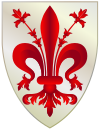Florence (Italy)
|
Florence Firenze |
|||
|---|---|---|---|
| Comune | |||
| Comune di Firenze | |||

A collage of Florence showing the Galleria degli Uffizi (top left), followed by the Palazzo Pitti, a sunset view of the city and the Fountain of Neptune in the Piazza della Signoria.
|
|||
|
|||
| Location of Florence in Italy | |||
| Coordinates: 43°47′N 11°15′E / 43.783°N 11.250°ECoordinates: 43°47′N 11°15′E / 43.783°N 11.250°E | |||
| Country | Italy | ||
| Region |
|
||
| Province / Metropolitan city | Florence (FI) | ||
| Government | |||
| • Mayor | Dario Nardella (PD) | ||
| Area | |||
| • Total | 102.41 km2 (39.54 sq mi) | ||
| Elevation | 50 m (160 ft) | ||
| Population (30 June 2016) | |||
| • Total | 383,083 | ||
| • Density | 3,700/km2 (9,700/sq mi) | ||
| Demonym(s) | Fiorentini, fiorentino | ||
| Time zone | CET (UTC+1) | ||
| • Summer (DST) | CEST (UTC+2) | ||
| Postal code | 50121–50145 | ||
| Dialing code | 055 | ||
| Patron saint | John the Baptist | ||
| Saint day | 24 June | ||
| Website | Official website | ||
Florence (/ˈflɒrəns/ FLOR-əns; Italian: Firenze [fiˈrɛntse]) is the capital city of the Italian region of Tuscany and of the Metropolitan City of Florence. It is the most populous city in Tuscany, with 383,083 inhabitants (as at 2013), expanding to over 1,520,000 in the metropolitan area.
Florence was a centre of medieval European trade and finance and one of the wealthiest cities of that era. It is considered the birthplace of the Renaissance, and has been called "the Athens of the Middle Ages". A turbulent political history includes periods of rule by the powerful Medici family and numerous religious and republican revolutions. From 1865 to 1871 the city was the capital of the recently established Kingdom of Italy. The Florentine dialect forms the base of Standard Italian and it became the language of culture throughout Italy due to the prestige of the masterpieces by Dante Alighieri, Petrarch, Giovanni Boccaccio, Niccolò Machiavelli and Francesco Guicciardini.
...
Wikipedia





